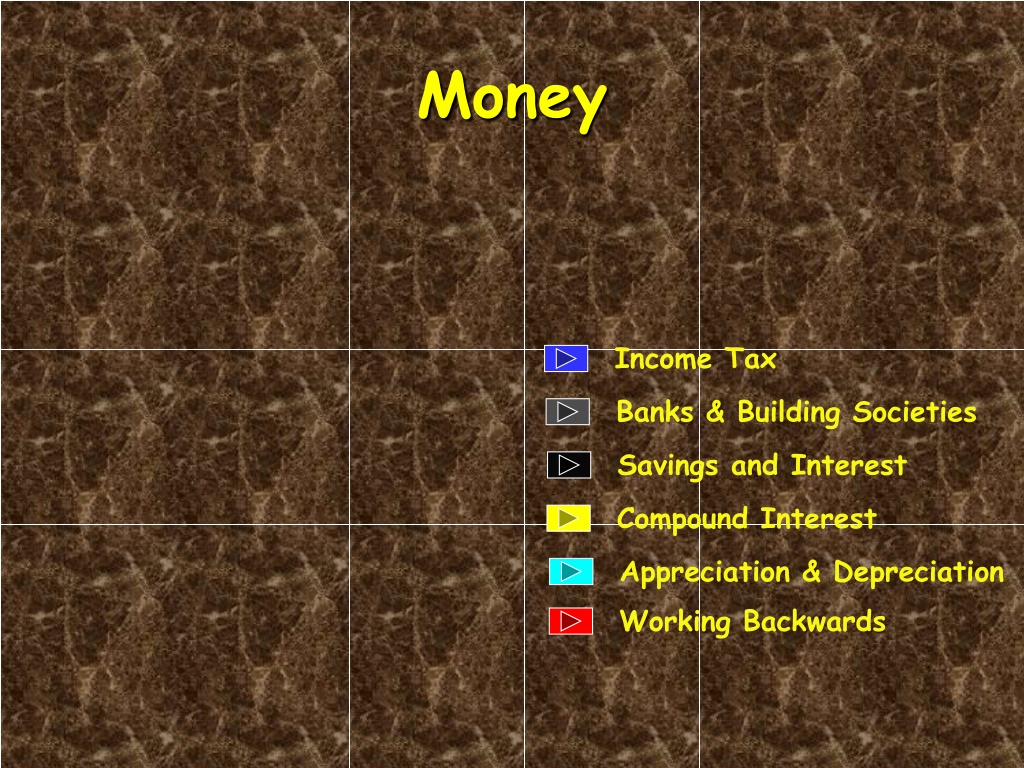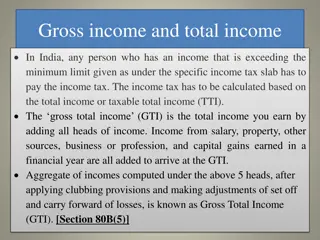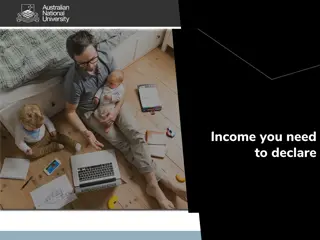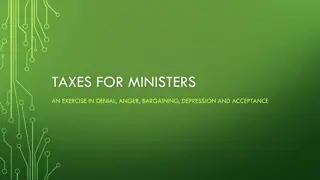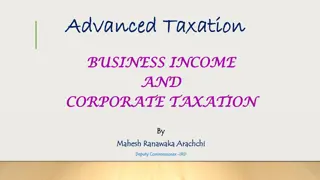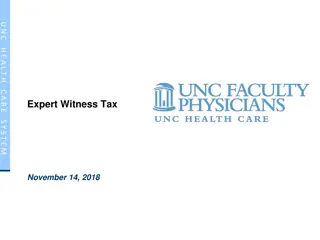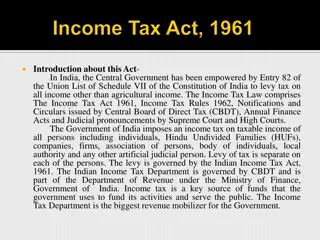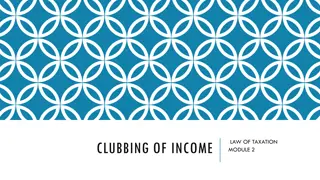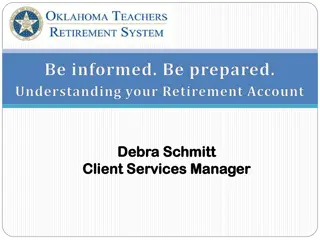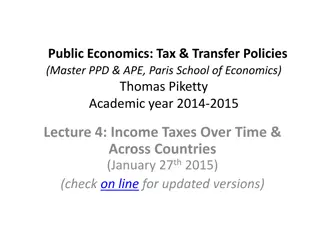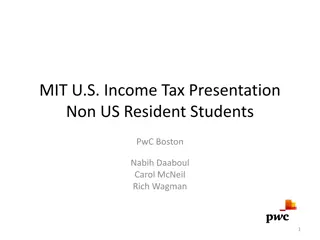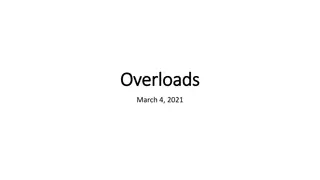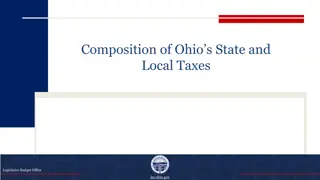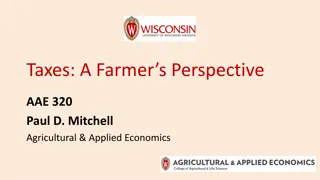Understanding Income Tax Calculation and Salary Calculation
This educational content covers various aspects of income tax calculation, including taxable rates, personal allowances, and calculations for different salary levels. It explains how to determine weekly, monthly, and annual salaries and provides examples of income tax calculations for different income levels. The content also touches on compound interest, depreciation, and appreciations related to money management.
Download Presentation

Please find below an Image/Link to download the presentation.
The content on the website is provided AS IS for your information and personal use only. It may not be sold, licensed, or shared on other websites without obtaining consent from the author. Download presentation by click this link. If you encounter any issues during the download, it is possible that the publisher has removed the file from their server.
E N D
Presentation Transcript
Money Income Tax Banks & Building Societies Savings and Interest Compound Interest Appreciation & Depreciation Working Backwards
Wages & Salaries Learning Intention Success Criteria www.mathsrevision.com 1. Understand the term weekly monthly and annual salary. 1. To explain how to work out weekly, monthly and annual salary / wage. 2. Calculate weekly, monthly and annual salary. 2-Oct-24 Created by Mr. Lafferty Maths Dept.
Income Tax Learning Intention Success Criteria 1. To explain how to work out Income Tax calculations. 1. Understand the term Income Tax. 2. Calculate Income Tax for a given salary.
Income Tax If your income in a tax year is below a certain value you do not pay tax. The tax allowance is made up of a personal allowance plus other special allowances. Special clothing equipment Membership of professional bodies
Income Tax Taxable Rates for 2004 / 05 Taxable income Up to 4745 0 - 2020 2020 - 31 400 Over 31 400 Rate of Tax 0% 10% 22% 40%
Taxable income Up to 4745 Rate of Tax 0% 10% 22% 40% Income Tax 0 - 2020 2020 - 31 400 Over 31 400 Calculate David s income tax if he earns 27 000 a year. Personal allowance 4745 Taxable Income 27 000 4745 = 22 255 Tax @ 10% = 10% of 2020 = 202 Tax @ 22% = 22% of ( 22 255 - 2020) = 22% of 20 235 = 4451.70 Total Income tax = 202 + 4451.70 = 4653.70
Taxable income Up to 4745 Rate of Tax 0% 10% 22% 40% Income Tax 0 - 2020 2020 - 31 400 Over 31 400 Lauren, a successful business woman earns 70 000. What is her total tax paid and her income after tax. Personal allowance 4745 Taxable Income 70 000 4745 = 65 255 Tax @ 10% = 10% of 2020 = 202 Tax @ 22% = 22% of ( 31 400 - 2020) = 6463.60 Tax @ 40% = 40% of ( 65 255 - 31 400) = 13 542 Total tax = 202 + 6463.60 + 13 542 = 20 207.60
Taxable income Up to 4745 Rate of Tax 0% 10% 22% 40% Income Tax 0 - 2020 2020 - 31 400 Over 31 400 Total tax = 202 + 6463.60 + 13 542 = 20 207.60 Income after tax = 70 000 - 20 207.60 = 49 792.40
Savings & Interest Learning Intention Success Criteria 1. To know the meaning of the term simple interest. 1. To understand the term simple interest and compound interest. 2. To know the meaning of the term compound interest. 3. Know the difference between simple and compound interest. 9
Savings & Interest Just working out percentages Simple Interest I have 400 in the Bank. At the end of each year I receive 7% of 400 in interest. How much interest do I receive after 3 years. How much do I now have? Interest = 7 100 400 = 28 After 3 years interest is 3 x 28 = 84. Total in bank is = 400 + 84 = 484 10
Compound Interest Learning Intention Success Criteria 1. To know when to use compound formula. 1. To show how to use the compound formula for appropriate problems. 2. Solve problems involving compound formula. 11
Interest calculated on new value every year Compound Interest Real life Interest is not a fixed quantity year after year. One year s interest becomes part of the next year s amount. Each year s interest is calculated on the amount at the start of the year. Principal value Example Daniel has 400 in the bank. He leaves it in the bank for 3 years. The interest is 7% each year. Calculate the simply interest and then the compound interest after 3 years. 12
Compound Interest Interest calculated on new value every year Daniel has 400 in the bank. He leaves it in the bank for 3 years. The interest is 7% each year. Calculate the compound interest and the amount he has in the bank after 3 years. Simple Interest Y1 : Interest = 7% of 400 = 28 Amount = 400 + 28 = 428 Y 2 : Interest = 7% of 428 = 29.96 Amount = 428 + 29.96 = 457.96 Y 3 : Interest = 7% of 457.96 = 32.06 Amount = 457.06 + 32.06 = 490.02 Interest = 7% of 400 = 28 3 x 28 = 84 Simple Interest is only 84 Compound is 490.02 - 400 = 90.02 13
Compound Interest This is called the multiplier. Easier Method n % = V I 1 100 n = period of time Days, months years I = initial value IMPORTANT = increase or decrease V = Value Can only use this when percentage is fixed 14
Compound Interest Calculate the money in the bank after 3 years if the compound interest rate is 7% and the initial value is 400. n = 3 I =400 n % = V I 1 = increase 1+0.07=1.07 100 3 = 490.02 V= 400 x (1.07) 15
Appreciation & Depreciation Learning Intention Success Criteria 1. To know the terms appreciation and depreciation. 2. Show appropriate working when solving problems containing appreciation and depreciation. 1. To understand the terms appreciation and depreciation. 16
Appreciation & Depreciation Appreciation : Going up in value e.g. House value Depreciation : Going down in value e.g. car value 17
Quicker Method Easier 1.79 x 64995 = 116341.05 Average house price in Ayr has appreciated by 79% over past 10 years. If you bought the house for 64995 in 1994 how much would the house be worth now ? Just working out percentages Appreciation = 79% x 64995 = 0.79 x 64995 = 51346.05 = Old Value + Appreciation = 64995 + 51346.05 = 116341.05 New value 18
Appreciation & Depreciation A Mini Cooper cost 14 625 in 2002 At the end 2003 it depreciated by 23% At the end 2004 it will depreciate by a further 16% What will the mini cooper worth at end 2004? End 2003 Depreciation = 23% x 14625 = 0.23 x 14625 = 3363.75 New value = Old value - Depreciation = 14625 - 3363.75 = 11261.25 19
Appreciation & Depreciation End 2003 Depreciation = 23% x 14625 = 0.23 x 14625 = 3363.75 = Old value - Depreciation = 14625 - 3363.75 = 11261.25 New value End 2004 Depreciation = 16% x 11261.25 = 0.16 x 11261.25 = 1801.80 = 11261.25 - 1801.80 = 9459.45 New Value 20
Work Backwards Learning Intention Success Criteria 1. To understand the process of work backwards. 1. To understand how to work backwards to find original price. 2. Solve problems using backwards process. 21
Work Backwards Example 1 After a 10% increase the price of a house is 88 000. What was the price before the increase. Deduce from question : 100 % + 10 % = 88 000 We have : 110 % = 88 000 1 % : 88 000 110 = 800 Price before is 100% : 800 x 100 = 80 000 22
Work Backwards Example 2 The value of a car depreciated by 15%. It is now valued at 2550. What was it s original price. Deduce from question : 100 % - 15 % = 2 550 We have : 85 % = 2 550 1 % : 2 550 85 = 30 Price before is 100% : 30 x 100 = 3 000 23
